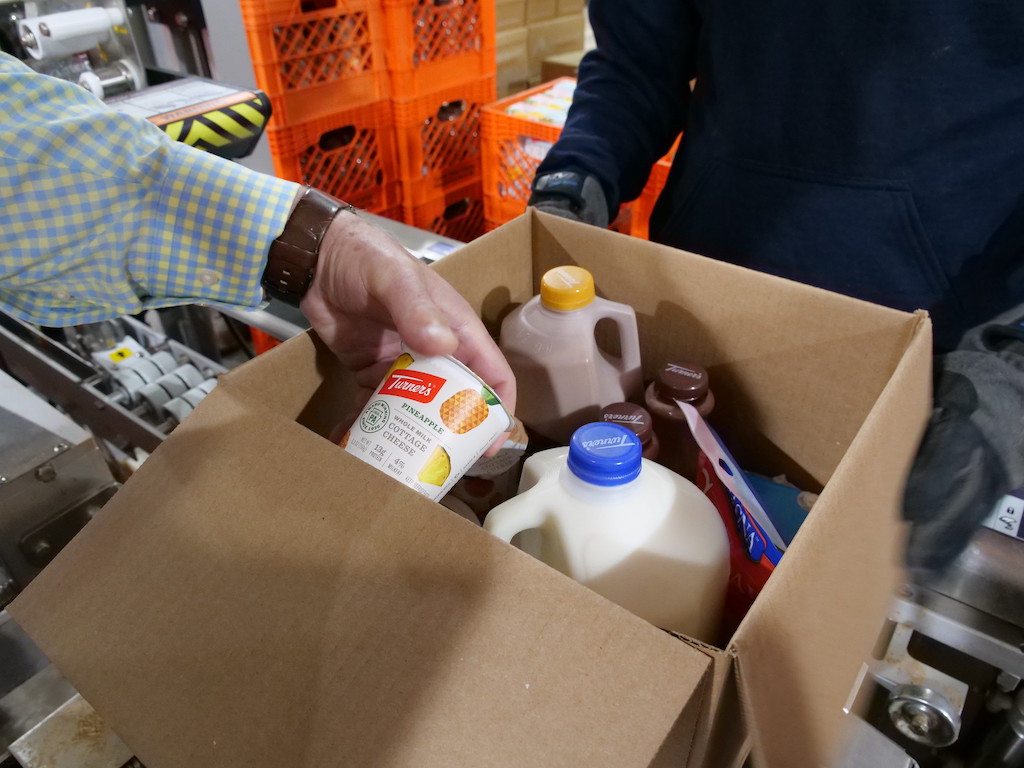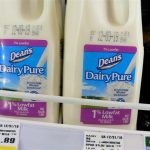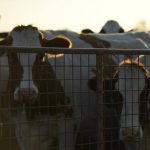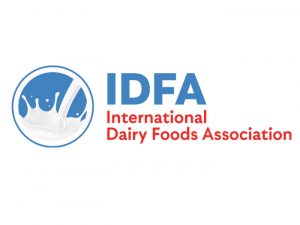
Like more than 500 other would-be federal contractors, Sherrie Tussler applied to be a part of the Department of Agriculture’s (USDA) Farmers to Families Food Box program on behalf of her food bank, Hunger Task Force. She asked for $37 million to move fruit, vegetables, dairy, and meat to pantries across the state of Wisconsin. “It was a pretty bold move on our part,” she says.
As Tussler worked her way through the proposal, she tried to set a price point for each gallon of milk that would both compensate dairies fairly and keep costs low. She settled on a range of $2.00 to $2.38 per gallon. Roughly a dollar would make its way back to the farmer, and the rest would go to packaging and transportation.
But Hunger Task Force was not awarded a food box contract. Instead, the opportunity went to a distributor in Kenosha and a school food provider in Chicago. Tussler was told her application failed because of a technicality. Tussler says the inexperienced contractors then struggled with the logistics, packaging produce in flimsy boxes that fell apart and sending five-pound bags of cooked chicken wings to senior citizens.
“If someone is paying more than $3 for a gallon of milk that is not organic … it would be the equivalent of a $100 hammer.”
Perhaps worse, Tussler’s careful attempt to keep costs low may have been in vain. The agency appears to be spending more per gallon on milk purchased through the food box program than average retail prices at the grocery store—even more than twice as much.
So far, USDA has not disclosed specifics about the average per-unit prices of food box contract awards, despite requests from politicians and members of the industry. However, an analysis by The Counter reveals the agency is sometimes paying higher-than-retail prices for fluid milk. Interviews with six dairies and distributors about the type and quantity of the boxes they plan to deliver on behalf of USDA, combined with back-of-the-envelope math using total dollar amounts awarded each entity, reveal that the agency is paying up to $7.05 per gallon of milk. According to USDA, the average retail price for milk at the grocery store was $3.36 per gallon in May. Five out of the six contractors appear to be charging the USDA more than that.
Asked about these numbers, Tussler sounded baffled. “If someone is paying more than $3 for a gallon of milk that is not organic … it would be the equivalent of a $100 hammer.”
A $5 gallon of milk might put $3 per gallon in the pocket of a dairy farmer. But if the agency chose contractors who promised to deliver at $2 per gallon, the same amount of taxpayer money would purchase more than twice the volume.
This agency’s opaque selection process for food box contractors has drawn heavy criticism, and these new details about milk prices cloud the picture even further. The food box program was an odd one from the start: Meant to support struggling farmers, distributors, and hungry people, it was never clear whose needs would carry the most weight during the application process. A $5 gallon of milk might put $3 per gallon in the pocket of a dairy farmer. But if the agency chose contractors who promised to deliver at $2 per gallon, the same amount of taxpayer money would purchase more than twice the volume. What emerges from this odd, unbalanced equation is the situation at hand: Gallons of milk purchased with public funds that cost well over the grocery store average, and organizations like Tussler’s that offered a much cheaper option and still lost out.
The program’s inherent contradictions raise questions about whether food boxes are the best way to funnel money to farmers and food to families. Might it not be more efficient to simply increase Supplemental Nutrition Assistance Program (SNAP) benefits and buy food from farmers through existing government channels?
Complicating matters even further, the agency appears to have changed its selection criteria to downplay the importance of price in between the time it solicited bids and the time it announced contract winners. In a list of Frequently Asked Questions published April 30, the agency listed price as the second-most important factor in would-be contractors’ applications. However, in an email to The Counter in late May, an agency spokesperson listed price as the least important factor out of four.
“Under the Farmers to Families Food Box Program, prices offered for fluid milk varied based on box configurations and delivery destinations.”
Some of the fluid milk boxes are pricier than others because they provide a premium product. For example, in Washington state, the Local Inland Northwest Cooperative is providing food banks with organic, grass-fed milk from a small-scale producer at $7.06 per gallon. But high-end milk is hardly the case across the board.
Even for conventional (non-organic) milk, USDA still appears to be paying higher-than-retail prices. For example, the agency is buying 344,000 boxes—each containing 9 half-gallon units—of fluid milk from GoFresh, a representative told us, which comes out to roughly $5.32 per gallon. Asked to confirm the per-gallon price, GoFresh referred us to USDA. Two other distributors we contacted also shared numbers that put their per-gallon price above $4. Another was about 50 cents above retail, and only one fell below.
In response to a request for comment, a USDA spokesperson said, “Under the Farmers to Families Food Box Program, prices offered for fluid milk varied based on box configurations and delivery destinations.”
Food isn’t always getting channeled from “farmers to families”—but rather, from farmers to broker to families.
Some of the apparent business arrangements between distributors and dairies raise further questions about whether or not the food box program is an efficient use of agency money. One of the program’s biggest fluid milk contractors is a company called Yegg, Inc., which received a contract worth nearly $16.6 million to distribute milk in the West Coast region. Until recently, the company advertised itself as a financial services provider.
As it turns out, Alta Dena, an arm of the now-bankrupt dairy processor Dean Foods, is overseeing the actual distribution of fluid milk boxes contracted to Yegg. In other words, food isn’t always getting channeled from “farmers to families”—but rather, from farmers to broker to families. Not only might this set-up raise the cost of food boxes, but it’s also in apparent contradiction with the program’s mission. (Yegg did not respond to numerous email and phone call requests for comment.)
The point of the Farmers to Families Food Box program, as indicated by its very name, is to circumvent grocery supply chains, and bring food from producers directly to “those in need.” It seems intuitive, then, that shortening the supply chain might lower the price of the end product. Generally speaking, manufacturers and distributors charge grocery stores wholesale prices, which are then marked up to account for marketing and operating expenses. The retail prices you see at, say, Kroger or Safeway, represent all of these costs. Why, then, is USDA paying even higher prices, despite the fact that its bulk food boxes should be going directly from manufacturers to food banks and pantries?
“What’s really needed is an expansion of [SNAP], or even something closer to a guaranteed minimum income so that people will actually have money to buy food themselves.”
There are a few logistical reasons—for example, new delivery routes and modified packaging—why distributors participating in the Farmers to Families model might incur additional costs, says Patrick Schallberger, CEO of Hollandia Dairy. (Hollandia placed a bid to distribute fluid milk in southern California, but wasn’t awarded a contract.) It’s also possible the cost of the milk we see at the grocery store doesn’t reflect the real cost of producing it. Retailers often price it lower than or at cost to draw more customer spending in other categories, Schallberger notes.
“Milk could be a loss leader,” Schallberger says. “You go to Walmarts in some areas of the country and they might have a gallon of milk for 99 cents. Nobody is selling [Walmart] a gallon of milk for 99 cents. They just have it in there to bring [people in.]”
Still, the apparent price paid by the agency raises questions about whether it might be more efficient to simply put more money in people’s pockets. House Democrats passed an aid bill raising SNAP benefits by 15 percent, though the legislation has not gained traction in the Senate.
“The main instrument in the United States for food assistance has really been SNAP,” says Bruce Rankin, executive director of the Westside Food Bank in California. “What’s really really needed is an expansion of that program, or even something closer to a guaranteed minimum income so that people will actually have money to buy food themselves, because all of this that we’re doing right now—a lot of it’s possible because a lot of people are out of other work, and [thus] available to volunteer … If this is going to be sustainable in the long run, [SNAP] is a program that certainly can’t be cut and needs to be enhanced as way to simplify things.”
“Yeah. So I’m not thrilled about the box.”
Tussler says she thinks the food box program could potentially be an effective solution to the specific challenges posed by Covid-19 if executed well. In normal times, many food pantries prefer to invite their clients inside so that people can choose their own groceries. Now, social distancing measures and staff shortages have necessitated drive-through models, forcing pantries to fill boxes in advance and limit client choice. “I mean, everybody’s got cultural preferences, dietary preferences, religious preferences that affect what they eat. And if you don’t respect those things, you waste food,” she said. “Yeah. So I’m not thrilled about the box.”
Pausing, she seemed to reverse course. At the end of the day, despite their flaws, many of these boxes are helping soften the blow of the damage caused by the virus. She shared an email from Jon Greendeer, a representative of the Ho-Chunk Nation, which received boxes that had been coordinated by her organization. “Today, we were not overlooked or put last in line. The gratitude expressed at the distribution sites is indescribable. The spirits of our community members have been lifted and we are extremely grateful. Pihinagigiwi (You’ve done well for us.),” it read.
“That almost brought me to tears,” she said. “And I’m not that kind of lady.”
























